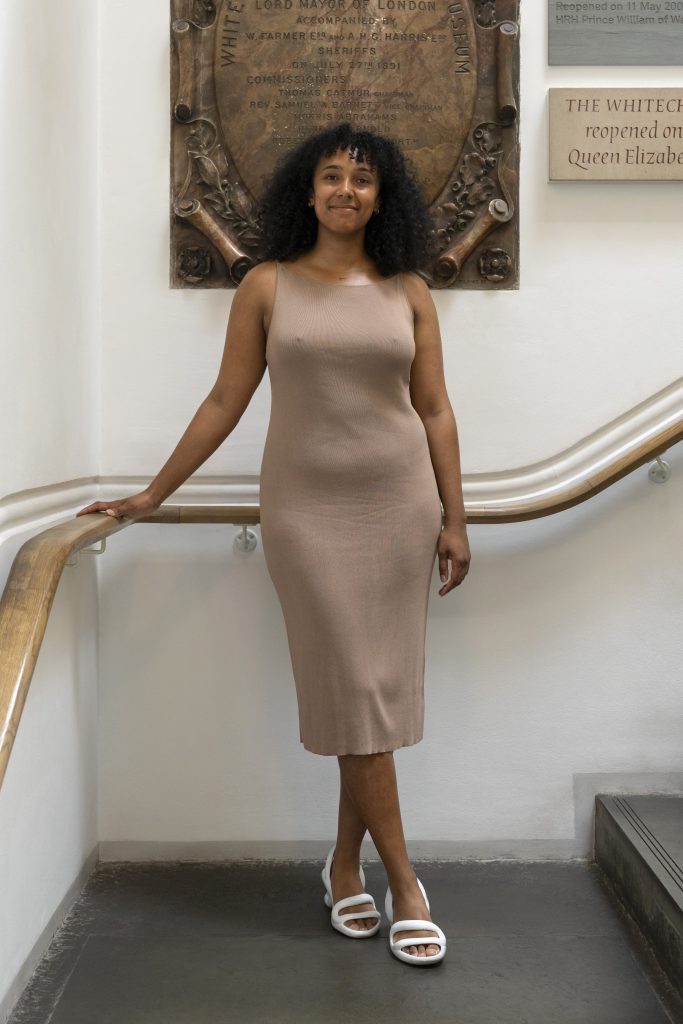
Deadweight. Dominique White wins Max Mara Art Prize for Women for her ‘disruptive’ maritime sculpture
By James Brewer
In maritime terminology, deadweight is the total weight of a ship’s cargo, fuel, ballast water, provisions for crew, and so on.
For the ingenious British artist Dominique White, the word signifies something darker and much ‘weightier.’ She deliberately inverts the nautical meaning, making it a schema “offering disruption as opposed to stability – a reckoning with the tipping point of the ship to offer the possibility of emancipation through abolition.”
Her long-standing fascination with maritime themes, and the history they embody, led to her winning submission for the ninth edition of the Max Mara Art Prize for Women. Deadweight is the title of the ghostly sculptural works she has constructed.
The Max Mara Art prize is a biennial award established in 2005 by Whitechapel Gallery and fashion house Max Mara with the further participation from 2007 of Collezione Maramotti, a private contemporary art collection in the headquarters of Max Mara in Reggio Emilia, Italy. It is the only visual art prize of its kind for up-and-coming UK-based women, offering the support and resources to create an ambitious new work.
Dominique’s sculptures, modelled from twisted iron and other nautical material, are on display at London’s Whitechapel Galley until September 15, 2024. The four large-scale works, displayed in a low-lit gallery, represent the artist’s interest in creating new worlds for ‘Blackness’ and intrigue, with the metaphorical potency and regenerative power of the sea. Her work envisions an Afro future, located outside traditional utopian science fiction, and inheriting an oceanic realm with the potential for fluid, rebellious realities, liberated from capitalist and colonial influence. “I grow [artistically] in moments of chaos,” she says.
Individually, the sculpted forms are categorised as The Swelling Enemy, Split Obliteration, Dead Reckoning, and Forged Iron. The whole emulates a destroyed vessel at sea, using shattered sails, worn-out hand-woven nets, mutilated anchors and deflated buoys which are cast and coated in a ghostly shroud of kaolin clay. The angular works combine force and fragility.
The gallery location is fitting: the Whitechapel area has had many connections through the centuries with mercantile trade and migration. Mile End Road was the final home of Captain James Cook from where in 1776 he left retirement for his final expedition, to search for the North-West Passage. Several mariners are buried in the grounds of the nearby medieval church of St Dunstan. Irish migrants were employed as labourers at the East End docks, and Jewish refugees from Eastern Europe and the Russian Empire fled by sea from persecution in the late 19th century to settle in Whitechapel.

Dominique’s project was supported by a six-month residency organised by Collezione Maramotti. This saw her travel to Agnone, Palermo, Genoa, Milan and Todi, working with academics, researchers and specialists in naval and maritime history and in the Mediterranean slave trade and migration. She was especially moved by the energy she discerned in the great port city of Genoa, derived from its centuries as a maritime power, which gave her important “references” for the creation of the pieces.
She enthusiastically toured historic foundries and artisan workshops, learning new skills from experts in historic, traditional and contemporary metalworking.
As part of the process, the sculptures – materials including driftwood, forged iron, sisal, raffia, destroyed sails, volatile charcoal matter, metal wire, sisal, raffia, destroyed sails, and “exhausted ropes” – were immersed in the Mediterranean. Dominique describes the soaking as “both a physical and poetic gesture to explore the transformative effect of water on material objects.”
It reinforced the notion of the works being in decay and falling apart. The metals display rust and oxidation, and elements carry the lingering scent of seawater. The forms evoke anchors, a ship’s hull, mammal carcasses or skeletons – lost or abandoned material forms that, through the artist’s treatment, become “symbols of defiance.” She uses their forceful unification to dissociate the motifs from their original function and redefine them as bodies charged with retaliation, protest and resilience.
Her website says that she weaves “the theories of Black Subjectivity, Afro-pessimism and Hydrarchy (from below) with the nautical myths of Black Diaspora” into “the Shipwreck(ed); a reflexive verb and state of being.”
Her research extends beyond the tangible, with a curiosity for both the destruction and ‘mythicism’ that hurricanes in the Caribbean leave in the sea. Dominique mostly lives in Marseilles and Essex. She was awarded the Foundwork Artist Prize of 2022 (US), has received awards from Artangel (UK), the Henry Moore Foundation (UK) in 2020 and the Roger Pailhas Prize (Art-O-Rama, France) in conjunction with her solo presentation with VEDA in 2019.
The judging panel for the ninth Max Mara Art Prize for Women was chaired by Bina von Stauffenberg, joined by gallerist Rózsa Farkas, artist Claudette Johnson, writer Derica Shields, collector Maria Sukkar and Whitechapel Gallery director, Gilane Tawadros.

Following its presentation at Whitechapel Gallery, Deadweight will move to Collezione Maramotti in Reggio Emilia, for exhibition from October 27, 2024, to February 16,2025.
The presentation at Whitechapel Gallery, which is accompanied by a short documentary film narrated by Dominique, is curated by the gallery’s curator for special projects, Katrina Schwarz.
The photos here of Dominique White at Whitechapel Gallery; of The Swelling Enemy; and of Split Obliteration at the gallery are © Above Ground Studio (Matt Greenwood)





